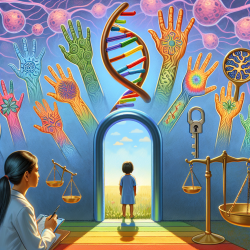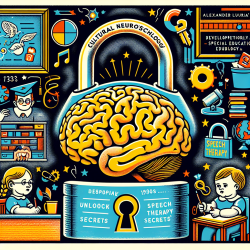Introduction
In the realm of speech-language pathology and childhood development, understanding the intricate connections between prenatal environments and childhood outcomes is crucial. A recent study titled "Gene expression in cord blood links genetic risk for neurodevelopmental disorders with maternal psychological distress and adverse childhood outcomes" sheds light on these connections. This research provides invaluable insights for practitioners aiming to enhance their skills and contribute to improved outcomes for children.
The Study at a Glance
The study examined gene expression in umbilical cord blood (UCB) from neonates born to mothers with varying psychological conditions, including PTSD and depression. By analyzing 149 samples, the researchers identified distinct gene expression patterns linked to maternal psychological distress. These patterns were associated with neurodevelopmental disorders such as autism spectrum disorder (ASD) and schizophrenia.
Key Findings
- Gene Expression Signatures: The study revealed unique gene expression signatures in neonates exposed to maternal PTSD and depression. These signatures were linked to pathways involved in axon guidance, mRNA stability, TNF signaling, and cellular stress responses.
- Neurodevelopmental Implications: The altered gene expressions were enriched with genetic risk loci for ASD and schizophrenia, suggesting a potential causal role in impaired developmental outcomes.
- Early Biomarkers: The findings support the search for early biomarkers to identify children at risk for developmental challenges, enabling timely interventions.
Implications for Practitioners
For practitioners in the field of speech-language pathology, these findings underscore the importance of early identification and intervention. By understanding the molecular underpinnings of neurodevelopmental disorders, practitioners can better tailor their therapeutic approaches to meet the unique needs of each child.
Moreover, the study highlights the need for a multidisciplinary approach, integrating genetic insights with traditional therapeutic methods. Practitioners are encouraged to collaborate with geneticists and other specialists to develop comprehensive care plans that address both the biological and behavioral aspects of neurodevelopmental disorders.
Encouraging Further Research
This study opens the door for further research into the molecular mechanisms linking maternal psychological distress to childhood outcomes. Practitioners are encouraged to stay informed about ongoing research and consider participating in studies that explore these connections. By contributing to the growing body of knowledge, practitioners can play a pivotal role in advancing the field and improving outcomes for children.
Conclusion
The insights gained from this research underscore the importance of a holistic approach to childhood development. By integrating genetic data with therapeutic practices, practitioners can enhance their ability to support children with neurodevelopmental disorders. As we continue to unlock the mysteries of gene expression and its impact on development, the potential for positive change in the lives of children is boundless.
To read the original research paper, please follow this link: Gene expression in cord blood links genetic risk for neurodevelopmental disorders with maternal psychological distress and adverse childhood outcomes.










